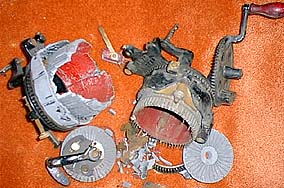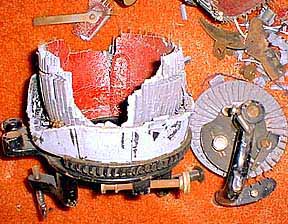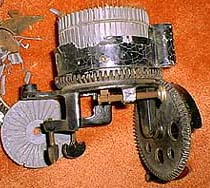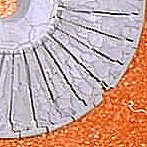


:-(

BUSTED BAD!
If you have no experience in fixing old knitters, it may be difficult to determine if a machine you are buying will work. This page contains some information on some obvious conditions that make a machine unusable. One thing that really helps you learn what not to buy, is to buy something at a premium price, then find out it will not work. I learn real good that way!
The Autoknitters from around the early 1900's often have cylinders and dials that are cracking and crumbling. I have heard of one Gearhart that had the same problem. The casting swells from the inside, making the cylinder warp and get bigger, while squeezing the slots smaller--often so small that the needles cannot be removed. The cylinder can swell enough to distort or crack the cast iron cam ring and gear ring. It is hard to tell how fast this happens--how long it takes from when you buy it serviceable with some damage, until it cannot be used. If anyone has experience with this, let me know and I will share it with everyone. Usually, if it does not have cracks, it's OK.
If the cylinder is warped and cracked it cannot be repaired, but it can be replaced by another cylinder, as long as the swelling cylinder did not damage the cam ring. Cylinders should be interchangeable among machines of the same brand, but may take a little hand fitting. Cylinders can be substituted from another brand, but may take a little machining to make it fit. Note, however, that the Gearhart cylinder is about 1/8 inch taller and uses longer needles than the Autoknitter and Master Machine.
Here are some pictures of two machines that cannot be repaired. If there are some useful parts, like the yarn feeder, crank, spring, thumb screws, weights, tension screw, etc., it still may be worth buying for a small amount--if you need the parts.
 |
These two Autoknitters will never see yarn. They were not dropped or abused, the zinc castings just swell. The one on the right almost looks useable, but look at it in the picture below. Both machines have crumbling cylinders, dials, and cam rings. |
 |
 |
| The dial on
the right is a close-up of the one in the picture
directly above it. Sad! :-( |
 |
Copyright, R. Kanko, 1998